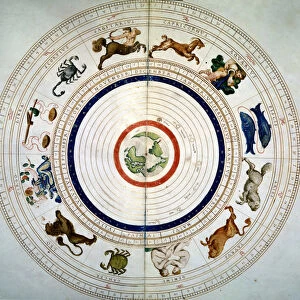Newborn baby, 16th century
![]()

Wall Art and Photo Gifts from Science Photo Library
Newborn baby, 16th century
Newborn baby. 16th-century artwork of a newborn baby boy, showing the umbilical cord (lower right) still attached. This cord, which provides a blood supply while in the uterus, is tied off and cut soon after birth. The remnant then dries up and falls off, leaving behind the umbilicus (the belly button). This woodcut is from Opusculum physiologum et anatomicum (1597) by the French physician and surgeon Severin Pineau (died 1619). Pineau specialised in obstetrics and gynaecology, writing books on these subjects that included more open discussion of the mechanics of human reproduction than was usual at the time
Science Photo Library features Science and Medical images including photos and illustrations
Media ID 6338839
© Todd-White Art Photography
1500s 1597 16th Century Baby Book Child French Gynaecological Gynaecology Gynecological Gynecology Infant Neonatal Neonate Obstetrics Page Re Production Reproductive Umbilical Cord Mono Chrome
EDITORS COMMENTS
This 16th-century artwork captures the delicate beauty of a newborn baby boy, showcasing an astonishing level of anatomical detail. Created by French physician and surgeon Severin Pineau, this woodcut print is from his renowned book Opusculum physiologum et anatomicum published in 1597. Pineau's expertise in obstetrics and gynecology allowed him to provide a rare glimpse into the mechanics of human reproduction during a time when such discussions were considered taboo. The monochrome illustration reveals the infant with his umbilical cord still attached, positioned prominently in the lower right corner. This lifeline served as a vital connection between mother and child while in the womb, supplying essential nutrients through blood circulation. Shortly after birth, it would be carefully tied off and severed, leaving behind what we now know as the belly button or umbilicus. Todd-White Art Photography has brilliantly captured this historical masterpiece that not only showcases artistic talent but also serves as an invaluable resource for medical research and understanding. The image offers insights into neonatal biology, reproductive anatomy, and early medical practices prevalent during the 1500s. As we gaze upon this remarkable piece of history, we are reminded of how far our knowledge has advanced over centuries thanks to pioneers like Severin Pineau who fearlessly explored subjects that were once shrouded in mystery.
MADE IN THE USA
Safe Shipping with 30 Day Money Back Guarantee
FREE PERSONALISATION*
We are proud to offer a range of customisation features including Personalised Captions, Color Filters and Picture Zoom Tools
SECURE PAYMENTS
We happily accept a wide range of payment options so you can pay for the things you need in the way that is most convenient for you
* Options may vary by product and licensing agreement. Zoomed Pictures can be adjusted in the Cart.



